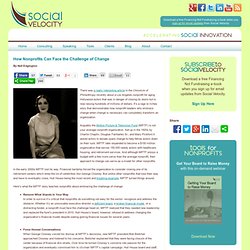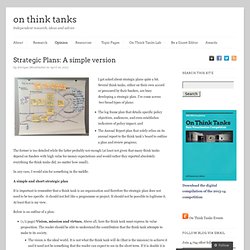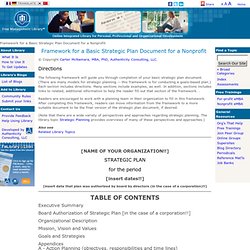

How Nonprofits Can Face the Challenge of Change. How Nonprofits Can Face the Challenge of Change By Nell Edgington There was a really interesting article in the Chronicle of Philanthropy recently about a Los Angeles nonprofit for aging Hollywood actors that was in danger of closing its doors but is now raising hundreds of millions of dollars.

Strategic Plans: A simple version. I get asked about strategic plans quite a bit.

Several think tanks, either on their own accord or pressured by their funders, are busy developing a strategic plan. I’ve come across two broad types of plans: The log frame plan that details specific policy objectives, audiences, and even establishes indicators of policy impact; andThe Annual Report plan that solely relies on its annual report to the think tank’s board to outline a plan and review progress; The former is too detailed while the latter probably not enough (at least not given that many think tanks depend on funders with high value for money expectations and would rather they reported absolutely everything the think tanks did, no matter how small). In any case, I would aim for something in the middle. The Best Companies Combine Marketing and Strategy - Roger Martin. By Roger Martin | 1:00 PM March 14, 2013 My dear friend AG Lafley and I have written a book called Playing to Win: How Strategy Really Works and we are gratified by all of the positive reviews — The Economist, the Financial Times, Fortune, etc.

Even on Amazon.com, the reviews have been 100% 4′s and 5′s.
Strategy Is All About Practice - Roger Martin. By Roger Martin | 1:00 PM February 20, 2013 I have never seen anybody become good at strategy without practice.

It may happen, but I have never seen it. I doubt that I will see it, because strategy is a discipline. Don't Let Strategy Become Planning - Roger Martin. By Roger Martin | 8:00 AM February 5, 2013 I must have heard the words “we need to create a strategic plan” at least an order of magnitude more times than I have heard “we need to create a strategy.”

This is because most people see strategy as an exercise in producing a planning document. In this conception, strategy is manifested as a long list of initiatives with timeframes associated and resources assigned. Somewhat intriguingly, at least to me, the initiatives are themselves often called “strategies.” That is, each different initiative is a strategy and the plan is an organized list of the strategies. Framework for a Basic Strategic Plan Document for a Nonprofit. © Copyright Carter McNamara, MBA, PhD, Authenticity Consulting, LLC.

Directions The following framework will guide you through completion of your basic strategic plan document. (There are many models for strategic planning -- this framework is for conducting a goals-based plan.) Each section includes directions. Many sections include examples, as well. Readers are encouraged to work with a planning team in their organization to fill in this framework. (Note that there are a wide variety of perspectives and approaches regarding strategic planning. Also seeRelated Library Topics. The 5 Building Blocks of Nonprofit Success. The 5 Building Blocks of Nonprofit Success By Nell Edgington There is a way off of the exhausting nonprofit hamster wheel of trying to do more and more with less and less. If your nonprofit can articulate the value you provide, strengthen your organization, develop a groundbreaking board, chart a strategic direction, and attract more support, you will set yourself up to achieve the holy grail of the nonprofit sector: lasting change to a social problem.
S 10 Must Reads on Strategy (with featured article "What Is Strategy?" by Michael E. Porter) Strategy and the Uncertainty Excuse - Roger Martin. Consider Not Setting Goals in 2013 - Peter Bregman. “Sophia, Daniel,” I yelled across the apartment at my seven-year-old and five-year-old who were playing together in their bedroom.

“The school bus arrives in 10 minutes. Let’s see who can brush their teeth and get to the door first.” They dashed towards the bathroom, giggling. Two minutes later, Daniel had won with Sophia a close second. I smiled at my own victory. The Disciplined Pursuit of Less - Greg McKeown. By Greg McKeown | 10:00 AM August 8, 2012 Why don’t successful people and organizations automatically become very successful?

One important explanation is due to what I call “the clarity paradox,” which can be summed up in four predictable phases: Phase 1: When we really have clarity of purpose, it leads to success. Phase 2: When we have success, it leads to more options and opportunities. Phase 3: When we have increased options and opportunities, it leads to diffused efforts. Demystifying Scaling: Part 4. A five-part series on developing a common framework for nonprofits to scale for impact.

So far, I have discussed four approaches to nonprofit scaling for impact versus size, including Service Enterprise, Technology-Driven, Train-the-trainer, and Advocacy. There are two others that make up this framework: Scaling Operations and Earned Income. Scaled Operations The Scaled Operations model is similar to what might be thought of as traditional scaling. Management Tools 2011 - Strategic Planning. May 08, 2013 Bain & Company guide Strategic Planning is a comprehensive process for determining what a business should become and how it can best achieve that goal.
It appraises the full potential of a business and explicitly links the business's objectives to the actions and resources required to achieve them. Strategic Planning offers a systematic process to ask and answer the most critical questions confronting a management team—especially large, irrevocable resource commitment decisions.
Usage and effectiveness among survey respondents. Canvanizer. A Business Model Canvas template for Open Office and Powerpoint. The tool of choice for investigating your business model One of the more popular tools that recently emerged in the “startup” landscape is Alex Osterwalder’s Business Model Canvas, as introduced in his book Business Model Generation.

It serves as the visual representation of his framework for analysis and further development of Business Models at all stages of their respective life cycles. A lot of people have started using it, pretty much at any Startup Weekend there are A0 printouts on the wall for teams to work with. When I first set out to use it for myself, I used the PDF template offered on the authors’ website.
That works fine as long as you do your work in hand writing and scribbles. What is the Business Model Canvas. Wanted talented people to join the startup!! 5 strategy questions. 5 Nonprofit Trends to Watch in 2012. Enabling Innovation using Lean Startup. The Idea That Led to 10 Years of Double-Digit Growth - Bill George - HBS Faculty. By Bill George | 8:00 AM November 1, 2012 In the mid-90s as CEO of Medtronic, I was concerned about whether we could sustain the remarkable success in innovation that we had enjoyed during the previous 10 years.
As we grew, I knew it would be very difficult to continue to create the breakthrough innovations that had led to Medtronic’s high growth rate, which had exceeded 18% per annum for a decade. Then I read Clay Christensen and Joe Bower’s 1995 article “Disruptive Technologies: Catching the Wave” in HBR. Christensen and Bower’s article offered the counterintuitive notion that great companies fail for the same reasons they initially experience success. They listen to their best customers — something we did religiously at Medtronic — making increasingly complex products to meet those customers’ most sophisticated needs. This process of “disruptive innovation” enabled new competitors to create entirely new product categories. How To Be In Business Forever: A Lesson In Sustainability.